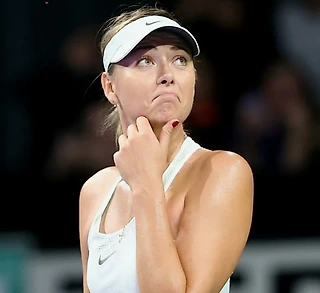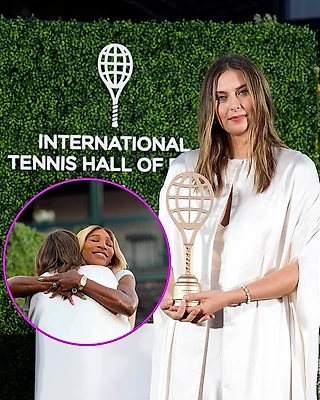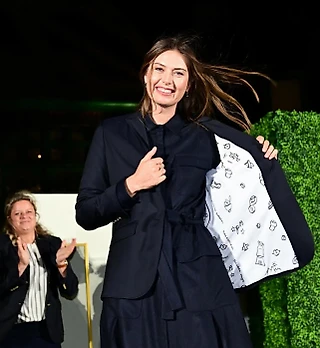Maria, the Punkess?
Для тех кто думают Джимми не сможет помочь Марии выставил статью Бодо.
Он "доказывает" что Джимми не может помочь Марии потому что Мария имеет уже все что Джимми умеет и может дать ей.
Бодо видит единственную пользу если Джимми может помочь Марии победить Серену.
Monday, July 15, 2013 /by Peter Bodo
The next time Maria Sharapova loses to Serena Williams, she just may drop all that “She’s a great player, she was just too good today” hooey and snarl, “I’ll follow that b**** to the ends of the earth. . .”
That’s the first thing that occurred to me when I read that Jimmy Connors is Sharapova’s new coach. The announcement was made recently at Sharapova’s website. This will be a marriage of Midwestern punk and Russian princess, creating what. . . Maria, the punkess?
That now-famous line I quoted was first uttered by Connors (with a slightly different curse) at Wimbledon in 1978, when he was asked if he would depart from his customary habit and travel to Australia at the end of the year if it meant preventing his rival Bjorn Borg from completing a career Grand Slam (at the time, the Australian Open was a grass-court event which began in late December). He spat out that brag after taking another whipping from the quiet, dignified Swede in the Wimbledon final.
Of course, Connors may not infuse (or is it poison?) Sharapova’s spirit with the animus that was one of his signal traits. It didn’t really work when Connors formed his last coaching partnership, with Andy Roddick. The protégé remained his edgy but witty and thoughtful self, in marked contrast to his ignorant, crass coach. More to the point, Connors was useful in various ways, but he never did get Roddick over the finish line of a Grand Slam. And that brings us to the question of the moment: “Why Connors?”
It’s a good question to which I can find no satisfying answer.
I say that partly because of the context. Thomas Hogstedt had been Sharapova’s coach for the past three years. A quiet, thoughtful Swede who avoided the limelight (shades of Borg!), Hogstedt re-invented Sharapova as a versatile player, and the net result for the current WTA No. 2 was a career Grand Slam, secured at last year’s French Open.
Hogstedt successfully navigated a complex situation when he signed on as (then) “co-coach” with Sharapova’s hitting partner, Michael Joyce, while both labored in the shadow of Sharapova’s father, Yuri. At the time, Sharapova was ranked No. 18 and spinning her wheels while attempting a comeback from shoulder surgery.
Hogstedt began to get results almost immediately and consistently. In fact, he may be the most underrated coach out there. But the two quietly called it quits soon after one of Sharapova’s few bad losses in recent years, a second-round failure at Wimbledon against world No. 131 Michelle Larcher de Brito.
It appears from Sharapova’s statement that the decision to separate was Hogstedt’s. The only part of the statement that isn’t boilerplate is: “Due to personal issues, he was not able to travel in the near future.”
Connors not only has very big shoes to fill, he’s got very different feet from the man he’s succeeding. Right off the bat, it will be interesting to see how the guy in the Members-Only jacket will get along in Sharapova’s glitzy sphere. He also brings a lot more personal baggage—and clout—to the job than did Hogstedt.
It starts with Connors’ own celebrity. His gig with Roddick represented a return to the limelight, and Connors appears to have enjoyed it. Now he has a tell-all autobiography to sell, and the U.S. Open represents his biggest potential hit. If you were disinclined to believe that Connors is a low-class, self-aggrandizing guy willing to sell out anyone he knows, you no longer have to take his critics’ word for it. You can just read “The Outsider,” in which he makes the case all by himself.
Connors, an eight-time Grand Slam champion, comes at a very high price (don’t ask me how I know this, but I do). This is something neither players nor coaches like to talk about, but it matters—sometimes a lot. Sharapova may have more money than God, but there will be significant pressure to keep the W’s keep rolling in at the pace established by Hogstedt, who presumably was paid considerably less than Connors is getting.
You can see how this promises to be a very interesting liason even before you get into the Xs and Os. Now let’s get into that.
Connors apparently worked a bit with Sharapova before the 2008 Australian Open, a stint that may have been facilitated by Roddick, who at the time was friends with Sharapova. I don’t recall much about that interlude, but here’s the strange thing to me about this new, formal partnership: Ageing punk and princess are already soul-mates of sorts, aggressive individuals who like to go right at their rivals, bellicose baseliners who hit flat, stinging shots and is forever looking to push back the opponent and move forward.
Neither Connors nor Sharapova have a good feeling around the net, and while Sharapova has a big if erratic serve, Connors’ own serve was poor, and one of the main reasons his succession of rivals—Borg, John McEnroe, and Ivan Lendl—all ended up mastering him.
So what’s Jimmy going to teach Maria? That down-the-line backhand? She already has it. How to unload with the forehand from the baseline and step into the court? She already does it. Unlike Roddick, she already has all the stuff that made Connors good, and even some elements of his game that weren’t so great.
Well, what about footwork?
Connors was one of the most nimble players, and that’s always been an area of concern for Sharapova. But under Hogstedt she made great strides (as attested by her win at Roland Garros), and it’s hard to see much room for improvement—the work’s already been done. Besides, I don’t see Connors as the kind of coach who’ll be found poring over research papers on how to improve footwork, or hobnobbing with the quasi-scientific fitness community.
Well, there’s that whole fighting spirit thing that Connors was famous for. . . But there again: Do you know anyone who thinks that Sharapova’s problem is that she’s too timid, too soft and friendly, or lacking in self-belief? What’s Connors going to do, encourage Sharapova to scream even louder, or clench her fist more ferquently?
There is one thing, though, and it probably would be worth a king’s ransom if Sharapova could pull it off: It’s what Connors might do to help her beat one player. And I think you all know of whom I speak.
Perhaps Sharapova hired Connors thinking that both the shake-up it represented and the nature of her new coach might somehow give her that extra bit of confidence she needs to take down Serena, whose 14-2 advantage in their non-rivalry tends to take some of the shine off Sharapova’s accomplishments.
Sharapova may be hoping that Connors’ simmering hostility and high degree of self-regard will rub off on her, or that the sight of his face in the player box will instill her with that extra bit of determination or self-belief she needs to break the Williams hex. Or maybe she’s just hoping that the liason will give Serena the jitters, or plant seeds of doubt. That would be worth the price she’s paying for Connors.
The funny thing is, if that comes to pass, it may be for reasons having a lot more to do with Williams’ age than anything Connors says, does, or represents. Serena will be quickly closing on 32 during the U.S. Open (Sharapova is just 26), and even she at some point must slow down. The one sure thing in this world is that Sharapova is quietly waiting, with a six-year advantage in age, to extract some payback from Williams. It will make Sharapova look much better in the history books.
In the end, this seems a dream gig for Connors, a match made in heaven, or perhaps in that other place.










А причина какая?
- может быть из-за Григора (самый худший, но и самый маловероятный вариант);
- может быть не готова для соревнования (не очень вероятный вариант так как у Марии были еще 8-9 дней для подготовки, ее первый матч мог быть только в среду или даже в четверг на следующую неделю);
- может быть из-за нового тренера лучше готовится вместе, чем играть в Стэнфорде (есть логика в таком варианте);
Но скоро узнаем. Если Мария и Григор будут вместе в ЛА папараци опубликуют некоторые фото. А может быть Мария и Григор будут вместе на ESPY завтра.
Поэтому я написал что для Марии и Джимми номер один не очень интересный, так как они знают всю эту простую арифметику.